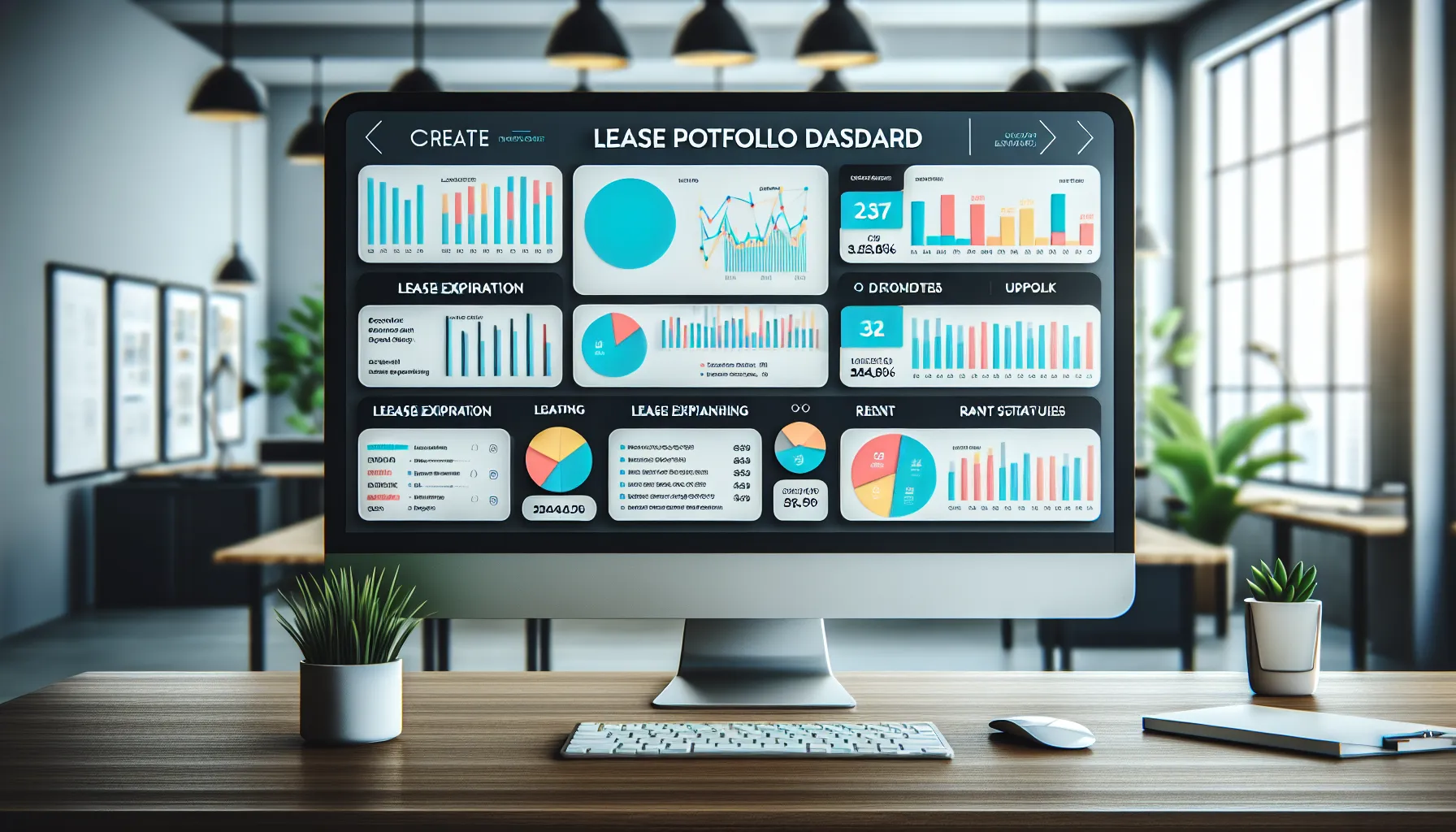Key Takeaways
- A lease portfolio dashboard streamlines property management in Menlo Park by centralizing leases, payments, and maintenance data for multiple rentals.
- Real-time data visualization and customizable reporting tools enable quick tracking of lease expirations, rent status, and inspections.
- Seamless integration with property management systems reduces manual work and ensures all data stays accurate and up-to-date.
- User-friendly interface design and automated notifications help property managers stay proactive, respond quickly, and improve communication with tenants and vendors.
- Key challenges include limited customization, data accuracy concerns, integration gaps, user permissions issues, and visual clutter in some dashboards.
- Adopting a well-designed lease portfolio dashboard enhances efficiency, reduces stress, and gives property managers greater control over their rental investments.
Managing multiple rental properties in Menlo Park can feel overwhelming, especially when every lease, payment, and inspection needs careful attention. I know how easy it is to lose track of important details when you’re juggling several properties at once. Wouldn’t it be helpful to have all your leasing information organized in one place?
A lease portfolio dashboard brings clarity and control to property management. With clear visuals and real-time updates, I can quickly see which leases are expiring, track monthly rents, and stay ahead on maintenance. How do you currently keep tabs on your leases, and what challenges do you face keeping everything organized? Let’s explore how a dashboard can make property management simpler and less stressful.
Overview of Lease Portfolio Dashboard Menlo Park
Managing several rental properties in Menlo Park often means sifting through paperwork, juggling tenant details, and keeping up with maintenance needs. I find a lease portfolio dashboard streamlines this process by gathering every key metric and document into one centralized platform. With visual tracking features, I can see lease expiration dates, pending payments, and inspection schedules without sorting through emails or files.
For landlords and investors who want clarity, the dashboard offers real-time updates on rent collections and late payments. Updates like these help me spot trends and act quickly if something changes. I don’t wonder whether a lease is expiring soon—the calendar view reminds me in advance, so I avoid stressful surprises. This simple overview makes complex management tasks feel approachable.
I appreciate reminders for property maintenance and easy access to monthly financial statements. These features let me make sense of revenue, expenses, and potential repair needs in seconds. It’s far easier to stay organized when data is at my fingertips rather than scattered across spreadsheets.
How are you currently keeping track of your properties? Do you ever wish you had a single place to review everything tied to your rentals? With a lease portfolio dashboard, I notice issues faster, answer tenant questions quickly, and plan ahead for each property. Clear insights keep my rental investments running smoothly, and I feel more confident managing multiple homes. What features would matter most to you in a dashboard?
Key Features of the Lease Portfolio Dashboard

Managing several leases or properties at once may feel overwhelming. A lease portfolio dashboard brings everything together, so I can spot important updates fast and focus on what matters most. What would simplify your daily workload the most?
Real-Time Data Visualization
Real-time data visualization gives me immediate insight into my entire portfolio. I see lease expirations, rent collection status, and maintenance updates without sorting through emails or spreadsheets. Graphs and charts offer a clear overview, making it easy to spot trends or urgent issues. If you prefer instant clarity instead of complex reports, is this type of visual summary something you value?
Customizable Reporting Tools
Customizable reporting tools let me create specific reports for leases, payments, and inspections. I adjust the dashboard to show the details that matter most for my properties—like payment history or upcoming maintenance tasks. Filters make it easy to focus on a single property or view all at once. What sort of reports would help you feel more in control of your properties?
Integration With Property Management Systems
Integration with property management systems connects all my lease data, tenant communications, and maintenance requests in one place. This reduces manual data entry and keeps everything in sync—from accounting to inspections. I avoid double-checking records across multiple platforms. How valuable would it be if your dashboard worked seamlessly with your existing management tools?
User Experience and Interface Design

I find that effective lease portfolio dashboards in Menlo Park put clarity first. User-friendly dashboards display key data—such as lease expirations, rent status, and inspection schedules—right where I can see them, minimizing time spent searching through separate files or emails. Well-organized menus and clear labels help me get where I need to go without confusion, even if I manage several properties at once.
Intuitive navigation builds confidence and saves time. Interactive charts and color-coded alerts quickly show me upcoming deadlines or overdue payments, so I can respond fast. I benefit from flexible layouts that fit my workflow, allowing me to arrange data tables or summary cards in a way that matches how I like to work.
Personalized settings are important, too. With adjustable notification preferences and filter options, I can focus on the details that matter most—like high-priority maintenance tasks or leases set to expire soon. Information is more useful when it arrives at the right moment.
Clear dashboards also support communication. Quick-access links or built-in messaging keep me connected to tenants and vendors, reducing delays. Real-time data refreshes keep every figure current, which means less second-guessing and more confidence in decisions.
How do you prefer to view your property data? What dashboard features would save you the most time each week?
Benefits for Property Managers in Menlo Park

Managing rental homes in Menlo Park involves juggling lease expirations, payments, inspections, and tenant requests. Using a lease portfolio dashboard makes this job simpler. I find everything I need in one place, from lease documents to rent summaries and upcoming maintenance dates. This level of visibility helps me avoid missing important deadlines.
Clear visuals and real-time updates help me spot issues fast. I see at a glance which rents are late or which leases are ending soon. This means I spend less time sorting through old emails or spreadsheets and more time acting on urgent matters. Do you ever wish you could respond faster to tenant concerns or maintenance requests?
Automated reminders take stressful guesswork out of my day. Scheduled alerts keep me on top of inspections, rent collection, and renewals. Set reminders help me stay proactive, so nothing slips through the cracks.
Custom reports let me view data that matters most. I can break down income by property, track overdue rents, and analyze maintenance costs. What kind of reports would help you make decisions with more confidence?
Quick access to key information supports better communication with tenants and vendors. I can answer questions faster, share updates, and provide detailed statements without extra effort. Have you noticed how faster communication can improve tenant satisfaction and retention?
For me, a dashboard means greater control and more peace of mind. I spend less time troubleshooting and more time improving each property’s performance. Which part of your workflow would you upgrade if managing data took less effort?
Challenges and Limitations

Managing several leases in Menlo Park using a portfolio dashboard presents distinct pressure points, even as it brings organization. I often see property managers feel overwhelmed by data volume, especially when portfolios include properties with varied terms, renewal cycles, and maintenance schedules. Many dashboards offer broad data collection, but pulling concise, actionable insights isn’t always easy if interfaces are cluttered or reports are too generic. Have you ever found yourself unsure which lease is set to expire next, even with a dashboard in place?
Limited customization becomes a sticking point for some. Not every dashboard aligns with my process or lets me highlight the specific information I need first, like overdue rents or maintenance status. Off-the-shelf solutions sometimes lack options to reorder visuals or add special reminders. How do you prioritize which data matters most for your daily tasks?
Data accuracy is critical. If updates are delayed or manual entry is required, I risk acting on outdated information. Inconsistent data feeds, especially from multiple sources, sometimes lead to errors in reporting rent collected, outstanding balances, or upcoming inspections. Have you ever questioned if the information in your dashboard matches your financial records?
Integration with other tools can fall short. While many dashboards claim seamless connections, gaps in data flow—such as tenant communications or maintenance requests—add manual work. If important records are scattered between systems, I find myself toggling between dashboards and email or spreadsheets, which wastes valuable time. Do you experience frustration trying to keep everything connected in one view?
User permissions and access levels present another barrier. With multiple team members involved, I want flexible permissions, but some dashboards restrict this. This can slow communication or prevent team members from accessing critical lease details. How do you handle access for assistants or partners who need a limited view?
Visual overload can happen with dashboards packed with charts, stats, and lists. Important alerts or deadlines get buried under too much information. Streamlined displays help, but many solutions favor data density over simplicity. When everything is highlighted, how do you spot the priority tasks?
Lastly, adapting to changes—such as adding new properties or shifting management workflows—can challenge dashboard scalability. I notice that some tools require manual updates or cumbersome setting changes when expanding a portfolio, which disrupts smooth operations. What problems have you run into when your property list grows or processes shift?
Which of these challenges resonates with your experience? Are there obstacles from your dashboard you’d add to this list?
Conclusion
After exploring the possibilities of a lease portfolio dashboard in Menlo Park I see how much it can transform the way I manage my properties. The right dashboard isn’t just about convenience—it’s about gaining control and insight that help me stay ahead of deadlines and tenant needs.
I’m always looking for tools that simplify my workflow and give me confidence in my decisions. If you’re managing several leases in Menlo Park it’s worth considering how a dashboard could make your life easier and your business more efficient.
Frequently Asked Questions
What is a lease portfolio dashboard?
A lease portfolio dashboard is a digital tool that helps property managers organize and monitor multiple rental properties. It displays real-time data on leases, rent payments, and maintenance schedules in one place, allowing for easier tracking and management.
How does a lease portfolio dashboard benefit property managers?
The dashboard centralizes key information, making it easier to monitor lease expirations, rent payments, and maintenance tasks. It offers real-time updates and visual insights, helping property managers quickly identify issues and stay organized without sorting through emails or spreadsheets.
What key features should I look for in a lease portfolio dashboard?
Look for features like real-time data visualization, customizable reporting tools, integration with property management systems, user-friendly interface, visual tracking of key dates, and personalized notifications. These help streamline operations and improve efficiency.
Can I customize reports in a lease portfolio dashboard?
Yes, many dashboards offer customizable reporting tools. You can create specific reports based on your preferences and needs, such as rent collection status, lease expirations, or maintenance history.
How does real-time data help in property management?
Real-time data ensures that you have the most current information about lease agreements, payments, and maintenance updates. This allows you to respond quickly to issues, make informed decisions, and avoid missed deadlines or overdue payments.
Are there any challenges with using a lease portfolio dashboard?
Yes, some challenges include data overload, limited customization, integration issues, and potential user restrictions. Adapting the dashboard to complex property portfolios and keeping data accurate can also be difficult as your portfolio grows.
How does a dashboard improve communication with tenants and vendors?
A dashboard streamlines communication by centralizing all relevant information, making it easy to share updates, reminders, and maintenance requests with tenants and vendors. This helps everyone stay informed and reduces miscommunication.
Is a lease portfolio dashboard suitable for landlords with only a few properties?
While dashboards are especially beneficial for managing multiple properties, even landlords with a smaller portfolio can benefit from organized data, clear visuals, and automated reminders, making property management more efficient.
